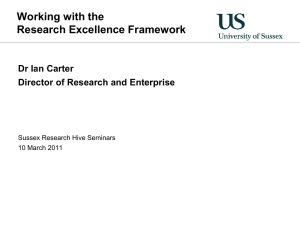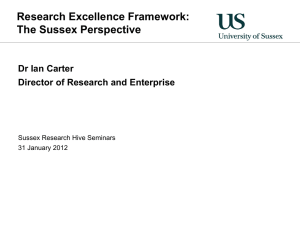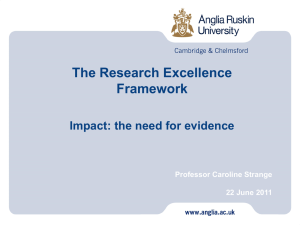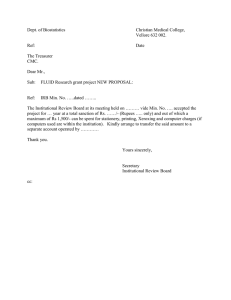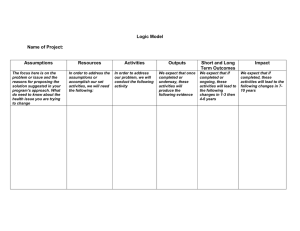The Research Excellence Framework: A brief guide to the proposals
advertisement
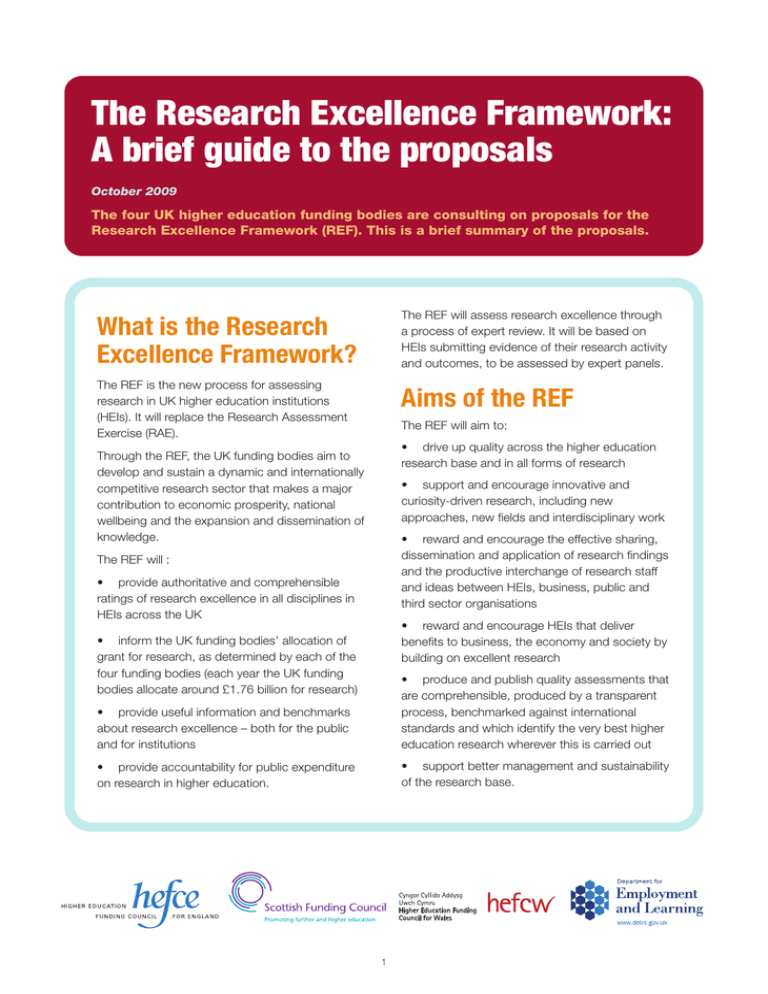
The Research Excellence Framework: A brief guide to the proposals October 2009 The four UK higher education funding bodies are consulting on proposals for the Research Excellence Framework (REF). This is a brief summary of the proposals. What is the Research Excellence Framework? The REF will assess research excellence through a process of expert review. It will be based on HEIs submitting evidence of their research activity and outcomes, to be assessed by expert panels. The REF is the new process for assessing research in UK higher education institutions (HEIs). It will replace the Research Assessment Exercise (RAE). Aims of the REF The REF will aim to: • drive up quality across the higher education research base and in all forms of research Through the REF, the UK funding bodies aim to develop and sustain a dynamic and internationally competitive research sector that makes a major contribution to economic prosperity, national wellbeing and the expansion and dissemination of knowledge. • support and encourage innovative and curiosity-driven research, including new approaches, new fields and interdisciplinary work • reward and encourage the effective sharing, dissemination and application of research findings and the productive interchange of research staff and ideas between HEIs, business, public and third sector organisations The REF will : • provide authoritative and comprehensible ratings of research excellence in all disciplines in HEIs across the UK • reward and encourage HEIs that deliver benefits to business, the economy and society by building on excellent research • inform the UK funding bodies’ allocation of grant for research, as determined by each of the four funding bodies (each year the UK funding bodies allocate around £1.76 billion for research) • provide useful information and benchmarks about research excellence – both for the public and for institutions • produce and publish quality assessments that are comprehensible, produced by a transparent process, benchmarked against international standards and which identify the very best higher education research wherever this is carried out • provide accountability for public expenditure on research in higher education. • support better management and sustainability of the research base. 1 Research excellence The REF will focus on assessing three elements, which together reflect the key characteristics of research excellence: Each of these three elements will be assessed against appropriate criteria for excellence, and rated by the expert panels on a five-point scale: Outputs – The primary focus of the REF will be to identify excellent research of all kinds, as demonstrated by the quality of research publications and other outputs. Impact – Significant additional recognition will be given where researchers have built on excellent research to deliver demonstrable benefits to the economy, society, public policy, culture or quality of life. • four-star (exceptional) • three-star (excellent) • two-star (very good) • one-star (good) • unclassified. Environment – REF will also assess how far the research environment supports a continuing flow of excellent research and its effective dissemination and application. How will research be assessed? Units of assessment and expert panels • to reduce the number of main panels to as few as four (broadly covering: the Medical and Life Sciences; Physical Sciences; Social Sciences; and Arts and Humanities) Assessment will be undertaken at the level of substantive bodies of research in coherent discipline groups – ‘Units of Assessment’ (UOAs). An expert sub-panel for each UOA will undertake the assessment, working under the guidance of a broader main panel. • greater standardisation of the criteria and processes across all panels, with scope to vary them only where justified by disciplinary differences. To simplify and achieve greater consistency across the exercise, we propose: We propose changes to the structure and working methods of the expert panels to ensure that they can robustly assess the breadth of material, and to strengthen the input of research users in the assessment – especially in assessing impact. • to reduce the number of UOAs and the number of fluid boundaries between them. We propose 30 UOAs and sub-panels, and invite feedback on these (in the 2008 RAE there were 67 UOAs). 2 Assessing outputs The quality of research outputs will be the dominant element of the assessment, as the most direct indicator of excellence and the foundation upon which impacts can be built. To assess the quality of research outputs, we propose: • HEIs should select which staff and which of their outputs to submit for assessment. HEIs will be encouraged to submit any eligible staff who have produced research of high quality during the assessment period. They will also be encouraged to put forward all types of highquality research output. • The criteria for assessing outputs will be ‘originality, rigour and significance’. (We define ‘significance’ as the capacity to make a difference either through intellectual influence within the academic sphere, or through actual or potential use beyond the academic sphere, or both.) • Sub-panels will assess outputs through a process of expert review. They will assess outputs against internationally benchmarked standards of excellence. To achieve a four-star (‘exceptional’) rating, outputs must be worldleading and meet the highest standards of originality, rigour and significance. • To reduce the considerable workload on panels of reviewing outputs, we suggest there may be a maximum of three outputs submitted per person (rather than four, as was the case in the RAE). • Some sub-panels will also make use of citation information – where robust data is available – to inform their assessment of outputs. How will citation information be used in assessing outputs? We conducted a substantive pilot exercise to test how to use citation information in the REF. We concluded that citation information is not sufficiently robust to be used formulaically or as a primary indicator of quality, but there is considerable scope for it to inform and enhance the process of expert review. We propose that: • Those UOAs for which robust data is available will make use of citation information. Sub-panels will decide this in advance. We expect that medicine, science and engineering panels will do so, but that the arts, humanities and a number of other panels will not. • We will provide the relevant panels with citation information about the number of times that submitted outputs have been cited, and with appropriate benchmarks. • These panels will use the information to inform and supplement their review of the outputs, to assist with achieving consistency, international benchmarking and where possible reducing workloads. • There will be clear guidelines on using the data robustly to take account of the known limitations and to avoid bias (for example, citations are less meaningful for recently published outputs, and are not available for certain types of output). Panels will not make judgements about the quality of outputs solely on the basis of citation information; expert judgement must be applied. All submitted outputs will be treated equally, whether or not there is citation information available for them. 3 – Assessing impact The REF will provide significant additional recognition where institutions and researchers have built on excellent research to deliver demonstrable benefits to the economy, society, public policy, culture or quality of life. To assess impact, we propose that: • The assessment will be made by the REF expert sub-panels, comprising people who understand research in the discipline and its wider use and benefits. Panels will be supplemented with members who are research users, to assess impacts. • A rounded assessment should be made of the impact of the submitting unit as a whole, not the impact of individual researchers. Submissions should provide examples of research-driven impact that arose from the unit’s broad portfolio of work. • Sub-panels should assess impact against criteria of reach (how widely the impacts have been felt) and significance (how transformative the impacts have been). They will form a subprofile showing the proportion of impacts meeting each level on the five-point scale. To achieve a four-star (‘exceptional’) rating, an impact would need to be ‘ground-breaking, transformative or of major value, relevant to a range of situations’. • The impacts must have been underpinned by high-quality research. The focus of REF is to identify research excellence, with additional recognition for strong impact built on that excellence. • Because of time-lags, especially with blueskies research, the impact must be evident during the REF assessment period, but the research may have been undertaken earlier (we suggest up to 10-15 years earlier). Impact pilot exercise • The assessment will be based on qualitative information informed by appropriate indicators. Submissions should include the following evidence of impact: – – The case studies and the impact statement should include appropriate indicators of impact, to support the narrative evidence. Given that the assessment of impact in the REF will be an important new feature but is comparatively untested, we are running a pilot exercise to test and develop the proposals. An impact statement, using a generic template, for the submitted unit as a whole. This will describe the breadth of interactions with research users and an overview of positive impacts that became evident during the assessment period. The pilot exercise will conclude in summer 2010. Decisions on the assessment of impact and its weighting within the framework will be taken in the light of the consultation exercise and the pilot outcomes. A number of case studies, using a generic template, to illustrate specific examples of impact and how the unit contributed to them. We propose one case study should be submitted for every five to 10 members of staff. Further information on the pilot exercise is available at www.hefce.ac.uk/ref Economic Social Quality of life Types of impact to be assessed Cultural Public policy and services Health Environmental 4 Assessing environment Overall outcomes REF will also assess how far the research environment supports a continuing flow of excellent research and its effective dissemination and application. We propose that: For each submission, the outcomes will be presented as: • a sub-profile for each of the three elements (outputs, impact and environment), which will show the proportion of submitted work meeting each level in the five-point scale • Submissions should include evidence of the research environment, using a common template. The template should include sections about: – resourcing (including staffing, research income, infrastructure and facilities) – management (including the forward strategy, staff development and training of postgraduate researchers) – engagement (including arrangements for the exchange of people and ideas with research user organisations, public engagement, support for interdisciplinary and collaborative research, and wider contributions to the research base and relevant esteem indicators). • an overall excellence profile, which combines the three sub-profiles. Overall the REF should give greatest recognition to submissions that demonstrate a combination of excellent research activity (as measured by outputs and environment) and strong impacts. The three elements will be weighted and combined to reflect this and to create strong but balanced incentives for researchers to build on excellent research activity to deliver strong impacts. As an indication of our current thinking we propose the following weightings between the three elements: • The evidence will be mainly qualitative, supported by key indicators including data about research income and postgraduate research students. We aim to develop a standard format for reporting these data, and to align this with data reported to the Higher Education Statistics Agency. Overall excellence 5 Outputs Impact Environment 60% 25% 15% The assessment timetable We propose to complete the first REF during 2013 to inform funding from 2014, as determined by each of the four UK funding bodies. This would entail the following timetable: 2010: The funding bodies will establish the expert panels and provide guidance to institutions on how to make submissions. 2012: Institutions will make submissions of evidence, made in a common format through the REF data collection system. 2013: A sub-panel for each UOA will assess submissions. They will create a sub-profile for each of the three elements (outputs, impact and environment), which will be combined to form an overall excellence profile. Sub-panels will recommend these outcomes to the main panels. 2013: Main panels will co-ordinate across sub-panels to ensure consistency in assessment, and will decide on the outcomes. 2013: The outcomes will be published. 2014: Each of the four UK funding bodies will decide on their use for allocating funds. The timetable will be finalised and guidance published during 2010, following outcomes of the consultation. Further information and how to respond The full set of proposals are available in the document ‘Research Excellence Framework: Second consultation on the assessment and funding of research’ (HEFCE 2009/38). This is available at www.hefce.ac.uk under Publications. We invite responses from all groups and organisations with an interest in the conduct, quality, funding and use of research. This includes HEIs, academic associations, businesses, public bodies, charities and other third-sector organisations. To respond, complete the response form at Annex A of the consultation document and return it by e-mail by Wednesday 16 December 2009 as described in the consultation. Further information: www.hefce.ac.uk/ref Enquiries to: ref@hefce.ac.uk 6

